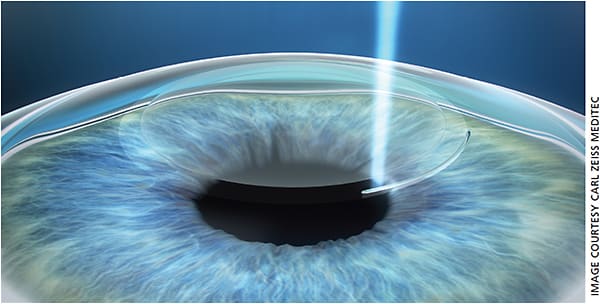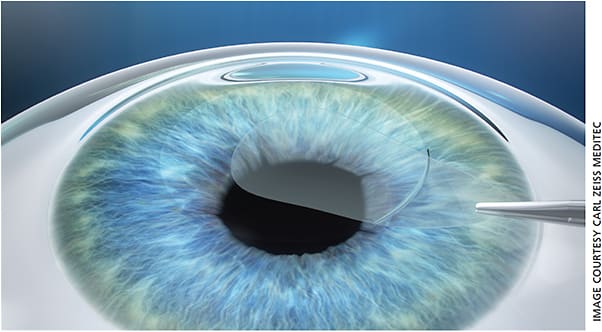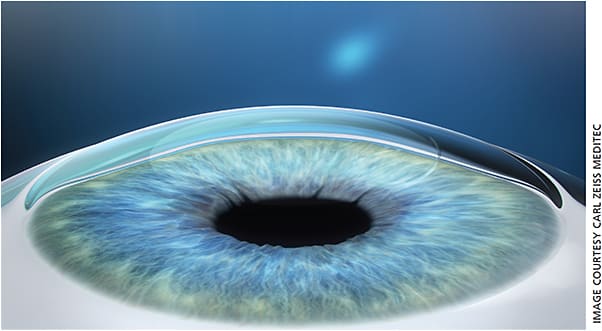In early March, some refractive patients in this country wishing to correct their myopia did so via the ReLex / SMILE procedure, now offered in a few U.S. practices. Those patients joined nearly 800,000 people worldwide who already have had the surgery; their surgeons joined the ranks of 600 or so practices.
For refractive surgeons who wish to learn SMILE and incorporate it into their refractive offerings, they’ll want to know that outcomes since March have been meeting expectations, says John F. Doane, MD, FACS, of Discover Vision Centers in Kansas City, Mo., a SMILE test site. “We’re essentially recreating what we saw in the FDA clinical trial,” he says. “There have been no hiccups and no surprises.” As of press time, the procedure had been in use for about seven weeks, and about 35% to 40% of eligible patients pursuing vision-correcting surgery were selecting SMILE, reports Dr. Doane. He has participated in another trial in patients with astigmatism that has been submitted to the FDA to expand SMILE’s indication.
“We’re now able to do visual correction surgery with just one laser,” says Phillip C. Hoopes Jr., MD, of Hoopes Vision in the Salt Lake City area. “The femtosecond laser does all of the steps of the vision correction surgery at one station. It allows us to correct vision without making a cornea flap.”
In this article, surgeons well familiar and already performing SMILE will provide pointers on learning, marketing and aligning the right patients with the procedure.
PROCEDURE MEETS PATIENT
The procedure offers a range of benefits for patients and surgeons, those interviewed for this article say. From a patient comfort level, says Gregory Parkhurst, MD, FACS, of Parkhurst NuVision in San Antonio, “It’s like nothing happened. That’s very different from what we’re used to with other femtosecond lasers.”
Dr. Parkhurst says he used to tell his patients after the flap was created that “the hard part was over” and they wouldn’t feel any more pressure. “I no longer need to say that because the first step, from a comfort perspective, is really no different or more involved than the excimer treatment.” Because the interface docks on the cornea with low suction, he adds, he no longer sees subconjunctival hemorrhage in his patients or gets postoperative queries about red splotches on patients’ eyes.
He is most pleased with the first 24-hour postoperative period. “What patients are saying is they didn’t even really feel like anything happened to their eyes other than they can see better,” he says — quite different from the same time frame following other corneal procedures, when patients would complain of stinging or burning.
The procedure resonates well with patients who are contact lens wearers, says Jon G. Dishler, MD, medical monitor for the U.S. IDE study. “They like the idea that you’re removing the small contact lens from their cornea, which makes sense to them because they put a contact lens in their eye, says Dr. Dishler of Dishler Laser Institute in Denver.
POLISH YOUR SURGICAL SKILLS
On the surgical side, for those who like learning new technologies, the procedure involves the surgeon more than LASIK, Dr. Hoopes says. “Even though the laser creates the treatment plan, the doctor still has to go in manually using instruments, separate the individual planes of the treatment and use skill to go within the cornea and free up the treatment to bring it out of the tunnel ... We kind of lost that with LASIK — LASIK became so automated that all the surgeon had to do was lift the flap, step on a pedal, and put the flap down ...What I like about SMILE is it forces the surgeon to really learn a new skill.”
A chat with Jon G. Dishler, MD
To read more about the procedure, see “A refractive surgery to SMILE about,” in OM’s June issue: http://www.ophthalmologymanagement.com/issues/2017/june-2017/a-refractive-surgery-to-smile-about .
The smaller incision means fewer changes to the biomechanical structure of the innate cornea, adds Dr. Doane. “That makes sense to anybody who does refractive surgery and that’s a benefit we’ve seen historically with PRK.” As a result, he says, “We’re not interrupting as many nerve fibers, so the chance of having dry eye [is less].” Furthermore, not having a flap means no worries about blunt force trauma, which is helpful for patients who have physically active jobs such as police or firefighters or those who enjoy physical contact sports like boxing or martial arts. And the bed, or interface, created by the laser “is extremely smooth,” Dr. Parkhurst says. “I like how that looks.”
Says Dr. Hoopes: “There are studies3,4 that now corroborate that this surgery had less incidence of dry eye at one month and six months compared to people who undergo LASIK.”
LEARNING TO SMILE
There are many people who have been told, for a variety of reasons, that they’re not candidates for refractive surgery, Dr. Parkhurst says, either due to myths that their cornea is too thin, they still would need reading glasses or the procedure would lead to worse dry eye than any contact lens-connected DED. Peer-reviewed literature reveals that isn’t true, even with modern LASIK. One recent study5 comparing those who kept their contact lenses compared to those who underwent LASIK found the LASIK patients said their eyes were less dry as compared to how they felt wearing contacts. SMILE may be advantageous for patients who struggle with contact lens intolerance or chronic dry eye from their contacts, he says.
Performing SMILE requires a bit of time to learn to do so, say Drs. Parkhurst and Hoopes, who each bought the lasers a little over a year ago and started using them for LASIK flaps. “I think that it’s necessary to get comfortable using the laser making flaps before diving into SMILE, because there are things that you learn in terms of docking and patient centration,” says
Dr. Parkhurst. As with other procedures, advises Dr. Hoopes, surgeons should spend a day observing another physician who’s performing the procedure to learn how that person selects patients and performs surgery and sees patients postoperatively. Last year, he traveled to Brazil to watch surgeons there performing SMILE.



GETTING THE WORD OUT
Marketing the procedure should be done carefully to avoid giving the false impression that SMILE is better than other eye surgeries: as Dr. Dishler says, “This procedure won’t really compete against LASIK — it’s a new market of patients who don’t want LASIK but do want something.”
Dr. Hoopes says without careful marketing, surgeons risk disappointing those patients who aren’t candidates. “The indications are still kind of limited ... we may give a false impression that LASIK is not an equal. LASIK is still the thoroughbred eye surgery in the United States. It has an impeccable track record, and some recent large case series studies like PROWL6 really confirm just how safe [it is] and how satisfied patients have been with LASIK.” That said, his office has used social media, print and television appearances to promote the technique, but everything is worded carefully to show SMILE as an additional — not better — option.
In San Antonio, “We have found the most effective way to announce the arrival of SMILE has been to educate the community that if they’ve been told they are not eligible to have vision correction surgery, a new safe and effective way to accomplish that goal is here,” says Dr. Parkhurst. This education has rekindled interest for those who once wanted refractive surgery but “were told somewhere along the line that they have to stay in their glasses or contacts.” He avoids marketing specific procedures to patients before meeting them, as he and his colleagues “don’t know which of the seven modern refractive surgery procedures a prospective patient needs until we’ve examined them.” His office has employed other means of spreading the message, including continuing education seminars for local referring doctors; radio; and in-house education pieces.
You can SMILE, too
So far this year, says Dr. Doane, Zeiss has completed two peer-to-peer surgeon training courses, with two more slated for the second half of 2017: in July at the American-European Congress of Ophthalmic Surgeries Summer Symposium in Deer Valley, Utah, and in November at the AAO’s Annual Meeting in New Orleans.
ANOTHER MILESTONE
So what does the future hold? If the US reacts like other countries to this procedure, refractive surgeons here will be fairly busy. “What’s happened outside the US has been remarkable,” says Dr. Doane, noting that some 70% of international patients are opting for SMILE in their home countries. “By the end of 2017, we anticipate that we’ll have done 1 million SMILE procedures worldwide. There’s not been a procedure that’s taken off like this since excimer laser vision correction.”
SMILE should be considered an addition to the refractive surgeon’s offerings, says Dr. Hoopes: “We should be getting pretty close to where we have a vision correction surgery for most every patient that comes in to the office, unless they have an eye disease that would prevent that.”
Dr. Parkhurst agrees. “The good news for patients is that we have procedures that can address each of their milestones of vision development. … With modern refractive surgery tools, we can get almost anybody to their goal of not having to wear glasses or contacts.” OM
REFERENCES
- Zeiss press release https://www.zeiss.com/meditec/us/media-and-news/latest-news/fda-approves-zeiss-visumax-smile.html
- “VisuMax SMILE Procedure Wins FDA Approval.” Review of Ophthalmology. Oct. 5, 2016. https://www.reviewofophthalmology.com/article/visumax-smile-procedure-wins-fda-approval
- Cai WT, Liu QY, Ren CD et al. Dry eye and corneal sensitivity after small incision lenticule extraction and femtosecond laser-assisted in situ keratomileusis: a Meta-analysis. Int J Ophthalmol. 2017 Apr 18;10:632-638.
- Kobashi H, Kamiya K, Shimizu K. Dry Eye After Small Incision Lenticule Extraction and Femtosecond Laser-Assisted LASIK: Meta-Analysis. Cornea. 2017 Jan;36:85-91.
- Price MO, Price DA, Bucci FA, et al. Three-Year Longitudinal Survey Comparing Visual Satisfaction with LASIK and Contact Lenses. Ophthalmology. 2016 Aug;123:1659-66.
- Eydelman M, Hilmantel G, Tarver ME, et al. Symptoms and Satisfaction of Patients in the Patient-Reported Outcomes With Laser In Situ Keratomileusis (PROWL) Studies. JAMA Ophthalmol. 2017 Jan 1;135:13-22.








